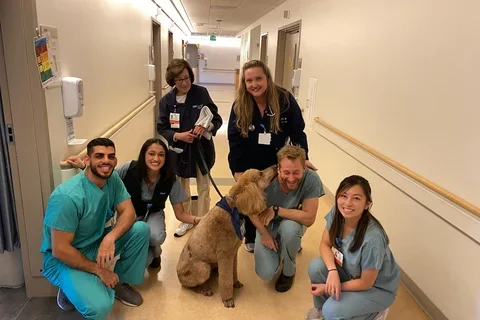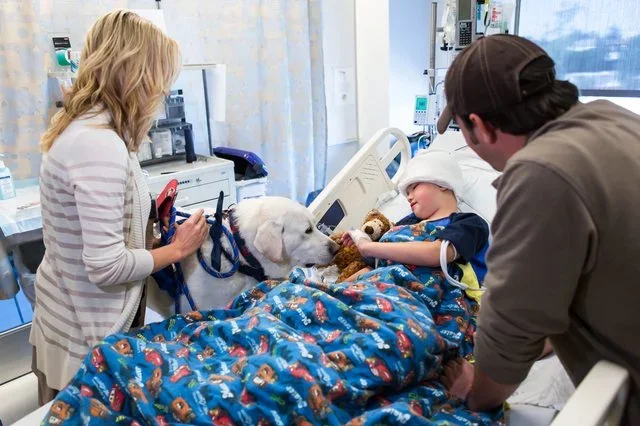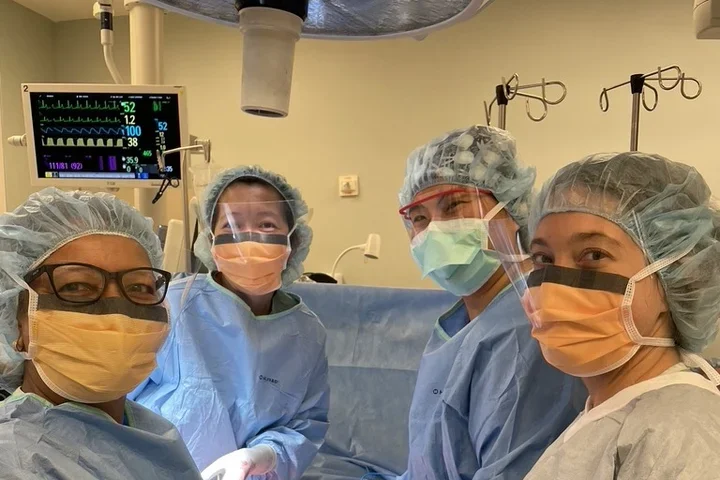What Is Animal-Assisted Therapy?
How You Can Get Involved

Improving the Patient Experience With Animals
Man's best friend isn't just a great companion at home—dogs also support healing in hospitals. That's why UCLA Health offers animal-assisted therapy. Through the People-Animal Connection (PAC), 60 human-dog volunteer teams visit more than 1,000 hospital inpatients each month.
"There's a special bond between human and animal," says Carey McCarthy, the director of volunteer services for UCLA Health. "Dogs provide unconditional love, and when people are in pain or feeling anxious about being in the hospital, dogs can be very comforting."
Research shows these furry visitors can also improve blood pressure, heart rate, respiratory function and depression and anxiety levels, sometimes with as little as a 12-minute visit. So what exactly is animal-assisted therapy and how does it work at UCLA?
How PAC Supports Healing
Patients schedule pet visits through their physicians, who must approve the requests. Then human-dog teams visit the patients and their families at the hospital.
Dogs are thoroughly groomed before each visit and undergo regular health screenings. Volunteers observe rigorous hygiene and infection control procedures. For example, each volunteer carries hand sanitizer for patients and families to use. They also place clean sheets over patient beds and remove them once the animal leaves the room.

McCarthy says the program is wildly successful with patients and staff. "Nurses tell our teams, 'This patient was having a terrible day, and you made all the difference.' Dogs have been influential in waking semi-conscious patients out of comas. We use them in the rehabilitation unit to help stroke victims regain motor function. They're also great with teen psychiatry patients, who might not want to communicate with people but feel safe expressing emotion around dogs," she says.
PAC volunteers also participate in several subprograms that use animals to help people, including UCLA Health's Operation Mend, which provides medical services to wounded warriors, the PetPal Program, which reunites patients with their own pets on hospital grounds, and as a stress reliever for students during finals week at the Powell Library at UCLA.
How It Works
PAC has grown from a single pet-therapy team in 1994 to more than 60 volunteer teams today, making UCLA's animal-assisted therapy program one of the most comprehensive in the nation.
McCarthy says her department wants to continue growing the program, but doing so requires time and money. PAC is completely donor-funded, and along with regular fundraisers, PAC accepts and appreciates donations through its website.
Pet owners who want to volunteer can also apply online, but McCarthy warns that there's a long waiting list and not all dogs make the cut. "We have a rigorous screening process due to the nature of our patient population," she explains. "We require dogs to receive behavioral training and certification from national organizations like Pet Partners before they can be considered for the program. Then teams go through months of training to ensure animals are appropriate for the hospital setting."
Size and breed don't matter as much as behavior and temperament. McCarthy says dogs must be fairly calm, respond well to basic commands and be comfortable interacting with all types of people. "The important thing is good social skills," she says. "But we have dogs ranging from 2 to 200 pounds, and we welcome a wide variety of breeds. The most popular seem to be golden retrievers, Labrador retrievers, poodles and French bulldogs."
McCarthy recommends pet owners learn as much as possible about animal-assisted therapy before applying, and then consider where their dogs would be the best fit. "While some dogs might not be suitable in a hospital environment, there are other organizations, such as libraries and nursing homes, that really benefit from pet therapy, too."



